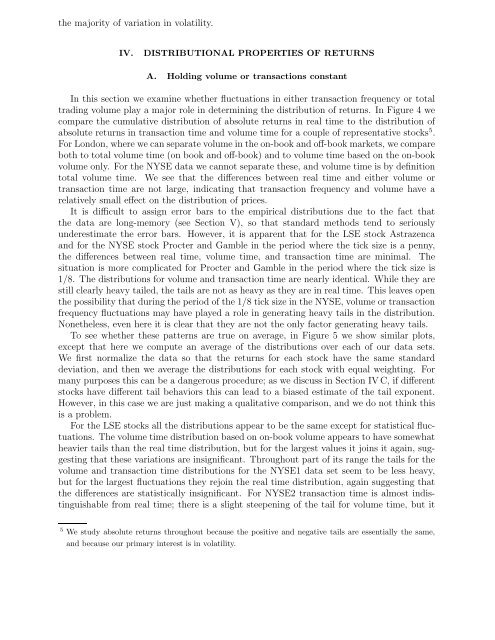There's more to volatility than volume - Santa Fe Institute
There's more to volatility than volume - Santa Fe Institute
There's more to volatility than volume - Santa Fe Institute
You also want an ePaper? Increase the reach of your titles
YUMPU automatically turns print PDFs into web optimized ePapers that Google loves.
the majority of variation in <strong>volatility</strong>.<br />
IV.<br />
DISTRIBUTIONAL PROPERTIES OF RETURNS<br />
A. Holding <strong>volume</strong> or transactions constant<br />
In this section we examine whether fluctuations in either transaction frequency or <strong>to</strong>tal<br />
trading <strong>volume</strong> play a major role in determining the distribution of returns. In Figure 4 we<br />
compare the cumulative distribution of absolute returns in real time <strong>to</strong> the distribution of<br />
absolute returns in transaction time and <strong>volume</strong> time for a couple of representative s<strong>to</strong>cks 5 .<br />
For London, where we can separate <strong>volume</strong> in the on-book and off-book markets, we compare<br />
both <strong>to</strong> <strong>to</strong>tal <strong>volume</strong> time (on book and off-book) and <strong>to</strong> <strong>volume</strong> time based on the on-book<br />
<strong>volume</strong> only. For the NYSE data we cannot separate these, and <strong>volume</strong> time is by definition<br />
<strong>to</strong>tal <strong>volume</strong> time. We see that the differences between real time and either <strong>volume</strong> or<br />
transaction time are not large, indicating that transaction frequency and <strong>volume</strong> have a<br />
relatively small effect on the distribution of prices.<br />
It is difficult <strong>to</strong> assign error bars <strong>to</strong> the empirical distributions due <strong>to</strong> the fact that<br />
the data are long-memory (see Section V), so that standard methods tend <strong>to</strong> seriously<br />
underestimate the error bars. However, it is apparent that for the LSE s<strong>to</strong>ck Astrazenca<br />
and for the NYSE s<strong>to</strong>ck Procter and Gamble in the period where the tick size is a penny,<br />
the differences between real time, <strong>volume</strong> time, and transaction time are minimal. The<br />
situation is <strong>more</strong> complicated for Procter and Gamble in the period where the tick size is<br />
1/8. The distributions for <strong>volume</strong> and transaction time are nearly identical. While they are<br />
still clearly heavy tailed, the tails are not as heavy as they are in real time. This leaves open<br />
the possibility that during the period of the 1/8 tick size in the NYSE, <strong>volume</strong> or transaction<br />
frequency fluctuations may have played a role in generating heavy tails in the distribution.<br />
Nonetheless, even here it is clear that they are not the only fac<strong>to</strong>r generating heavy tails.<br />
To see whether these patterns are true on average, in Figure 5 we show similar plots,<br />
except that here we compute an average of the distributions over each of our data sets.<br />
We first normalize the data so that the returns for each s<strong>to</strong>ck have the same standard<br />
deviation, and then we average the distributions for each s<strong>to</strong>ck with equal weighting. For<br />
many purposes this can be a dangerous procedure; as we discuss in Section IV C, if different<br />
s<strong>to</strong>cks have different tail behaviors this can lead <strong>to</strong> a biased estimate of the tail exponent.<br />
However, in this case we are just making a qualitative comparison, and we do not think this<br />
is a problem.<br />
For the LSE s<strong>to</strong>cks all the distributions appear <strong>to</strong> be the same except for statistical fluctuations.<br />
The <strong>volume</strong> time distribution based on on-book <strong>volume</strong> appears <strong>to</strong> have somewhat<br />
heavier tails <strong>than</strong> the real time distribution, but for the largest values it joins it again, suggesting<br />
that these variations are insignificant. Throughout part of its range the tails for the<br />
<strong>volume</strong> and transaction time distributions for the NYSE1 data set seem <strong>to</strong> be less heavy,<br />
but for the largest fluctuations they rejoin the real time distribution, again suggesting that<br />
the differences are statistically insignificant. For NYSE2 transaction time is almost indistinguishable<br />
from real time; there is a slight steepening of the tail for <strong>volume</strong> time, but it<br />
5 We study absolute returns throughout because the positive and negative tails are essentially the same,<br />
and because our primary interest is in <strong>volatility</strong>.
















